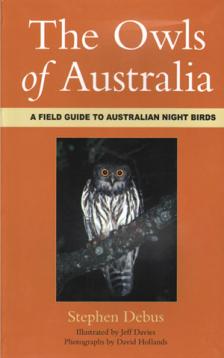Owls of Australia
Originally in: Emu, 2010, 110, p186. CSIRO Publishing.

Undertaking research on owls is filled with many challenges, the most obvious being working on cryptic species in the dark. Trying to identify species can be very difficult, especially if your observations are based on the silhouette of a non-vocal owl roosting high in the canopy where its size is difficult to estimate through the foliage. If you are lucky this silent flier will do a fly-by over your head, or better still, call to a mate, giving you the chance to identify it. In many situations, however; the owl will not be so obliging and will remain silent in its roost, leaving you to wonder: was it a masked owl or maybe a sooty owl or possibly a barn owl?
The Owls of Australia - a field guide to Australian night birds by Stephen Debus will certainly help with these owl identification problems. This field guide provides a concise summary of Australia's different owl species, focussing primarily on the identification and basic biology of individual species. The guide begins with a generic chapter on owls and then provides separate chapters for the two owl families and within these chapters sections on the Australian owls that fall within each family. This field guide also contains a chapter on the identification of frogmouths, which is helpful as frogmouths are often misidentified as owls.
The opening chapter of this guide provides a very useful overview of owls, including information about their taxonomy and the characteristics of the two owl families found in Australia, the Tytonidae (barn owls) and the Strigidae (hawk owls). This chapter also provides an overview of food and hunting, behaviour, reproduction, handling and studying owls, distribution, threats and conservation and finishes with nomenclature and species limits. Chapter two provides a brief overview of owls in the fossil record.
Chapters three and four provide relevant information about each owl species found in Australia. Chapter three represents the hawk owls (genus Ninox). There are separate sections for each of the five Ninox owls found in Australia (Powerful Owl, Rufous Owl, Barking Owl, Southern Boobook and Christmas Island Hawk-Owl) under the headings: Description and voice, Distribution, Food and hunting, Behaviour, Breeding, and Threats and conservation. The same format is used for the barn owls (genus Tyto) in chapter four which includes all five species of Tyto found in Australia (Sooty Owl, Lesser Sooty Owl, Masked Owl, Eastern Barn Owl and Eastern Grass Owl).
The information provided for each species is concise and well written. The format makes this field guide easy to use and the explanations of the differences between similar species will definitely make correct owl identifications more likely. Coloured plates of each species are also included in the guide. These plates depict both adults and juveniles with a combination of roosting and flying birds, further highlighting differences between species.
Information about frogmouths (genus Podargus) is found in chapter five. This chapter contains an overview of frogmouth characteristics and highlights the differences between owls and frogmouths. The Tawny Frogmouth, Papuan Frogmouth and Marbled Frogmouth are all described with information about the distribution and habitat of each species. The inclusion of this chapter will help dispel the misbelief that frogmouths are owls.
This field guide concludes with a chapter about threats, conservation and the future. Debus highlights the pressures faced by Australian owls such as habitat destruction, pesticides and pollution and persecution. He also discusses research and management, reserves, habitat restoration and enhancement, pest management, education, rehabilitation and the future. This chapter is a neat summary of human interactions with these species. It reinforces the ecological and social importance of Australian owls and suggests areas where future research and conservation should be focussed.
Overall, The Owls of Australia - a field guide to Australian night birds is a must-have field guide for any owl enthusiast. This guide is concise (106 pp.) and easy to use with all the Australian owls included and the differences between these species are highlighted. The guide is well referenced and also contains a short glossary of key terms. I have no hesitation is recommending this guide as essential for anyone venturing out at night to study owls.
